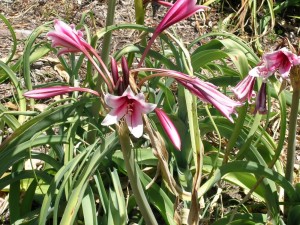Family: Amaryllidaceae
Synonymous: Amaryllis bulbisperma
Crinum capense
Distribution and habitat: Crinum bulbispermum is a herbaceous plant native to South Africa. It is naturalized in other parts of the world, such as southern North America. In nature it grows along stream banks and in swampy grasslands that usually dry out during the winter months when these plants are dormant.
Description: Crinum bulbispermum has a large 8 to 10cm (3-4 inch) tick oval bulb with 'neck' up to 15cm (6 inch) or even 30cm (12 inch) long from which rise about 10 spreading, sword-shaped leaves. Each slender pointed leaf is 60-79cm (24-31 inch) long and 5-8cm (2-3 inch) wide. The inflorescence is an umbel with 813 flowers, borne on a scape 4075cm (16-30 inch) tall. The flowers are funnel shaped and sickly-sweet scented. Flower colour is white, deeply ringed with pink on the outer surface of the petals.
The species generally grown as indoor plants usually keep their leaves for at least one full year, after which the leaves tend to slowly become shabby and untidy. When finally drop off or are picked off, fresh new leaves appear. the plants therefore need considerable attention to keep the foliage looking presentable.
Clusters of five to eight impressive trumpet shaped flowers are normally produced in autumn on 60-90cm (24-35 inch) long flower stalks. Each of these long stalks may be 2cm (0.8 inch) tick and the flowers are usually about 15cm (6 inch) across with mouths up to 15cm (6 inch) across. The handsome display of blossom last for about a month. Plants may take three to four years to reach flowering size.
Once the flowers fall they are followed by the large attractive pink fruit capsules containing few to many bulbous seeds which germinate as soon as they fall to the ground.
Houseplant care: When section of leaves turn yellow or show signs of damage, cut away the unsightly portion. Entire leaves need not to be cut away unless it is really necessary.
Light: Crinum bulbispermum need at least three hours a day of direct sunlight. Inadequate light inhibits flowering and can cause unnaturally elongated leaves.
Temperature: Crinum bulbispermum plants grow well in normal room temperatures for most of the year, but need a three months rest period at 10C (50F) in midwinter.
Watering: During the active growth period water plentifully, but never let the pot to stand in water. During the winter rest period give just enough water to prevent the potting mixture from drying out.
Feeding: Apply liquid fertilised once every three weeks during the active growth period only.
Potting and repotting: Use a soil based potting mixture. Place the bulb in a pot that is only a couple of centimetres (0.8 inch) wider than the bulb. If bulbs are small, plant two or three in a 25-30cm (10-12 inch) pot or tub, standing each one half in and half out of the potting mixture. Leave plenty of space above the potting mixture, which will be forced upwards as more roots are produced.
Once they are potted, Crinum bulbispermum plants are most likely to flourish if left undisturbed. Do not attend to separate bulb clumps or to move plants into bigger pots for at least three years. Instead give the plants an annual spring top-dressing.
Gardening: This is one of the most commonly cultivated species, grown as an ornamental plant for its flowers. The species is hardy to zone 6b if the bulb is protected.
Location: Crinum bulbispermum plants require full sun or semi-shaded position.
Soil: Rich and well drained but generally tolerant of a wide range. Adult Crinum bulbispermum plants are best grown in deep soils that receive and hold a lot of water during the growing season. They can be transplanted but ideally should be left to grow in the same place without disturbance.
It does prefer the wetter places and does very well if planted in soggy soils.
Plant Crinum bulbispermum with the top of the bulb just above the soil surface and 30cm (12 inch) apart each other.
Irrigation: Although this plant is very drought tolerant once established, it performs best if the soil is kept moist once the foliage appears until the time when the flowers have finished. They can endure periods of drought during their growing season without adverse effects.
Fertilise: Top dress annually in Spring with a general purpose fertiliser.
Propagation: Clumps of bulbs form as the plant age. To propagate, divide overcrowded clumps in spring by pulling them apart gently. Pot the bulbs up either singly or in groups of two or three. Then work the potting mixture around the fleshy roots and press it down thoroughly. For six weeks after potting up, water sparingly. Thereafter, treat the plants as adults.
Recommended varieties:
Crinum bulbispermum cv. 'Album' has pure white blooms.
Crinum bulbispermum cv. 'Backup Mother' - vigorous. Flowers medium pink with white throat.
Crinum bulbispermum cv. 'Spotty' - flowers rose-purple with odd random white spots and unpigmented, short stripes.
Crinum powellii is a hybrid of which parentage is Crinum bulbispermum Crinum moorei. It has 10cm (4 inch) tick globular bulb and up to 20 sword shaped leaves. Each leaf is about 1m long and 8-10cm (3-4 inch) wide near the base. The flowers are pinkish red with green shading near the base of the petals.
Uses and display: This is a good plant for swamp or water gardens. It can be used in designing cottage or informal gardens or as flower borders or beds. They also make good container plants.
SUMMARY:
CHARACTERISTICS:
Foliage green
Features - flowers
Shape bushy
Height: 1-3m (3-10 feet)
PROPER CARE:
Watering in rest period sparingly
Watering in active growth period plentifully
Light direct
Temperature in rest period min 10C max 13C (50-55F)
Temperature in active growth period min 16C max 24C (61-75F)
Humidity low
Hardiness zone 6b-10b






